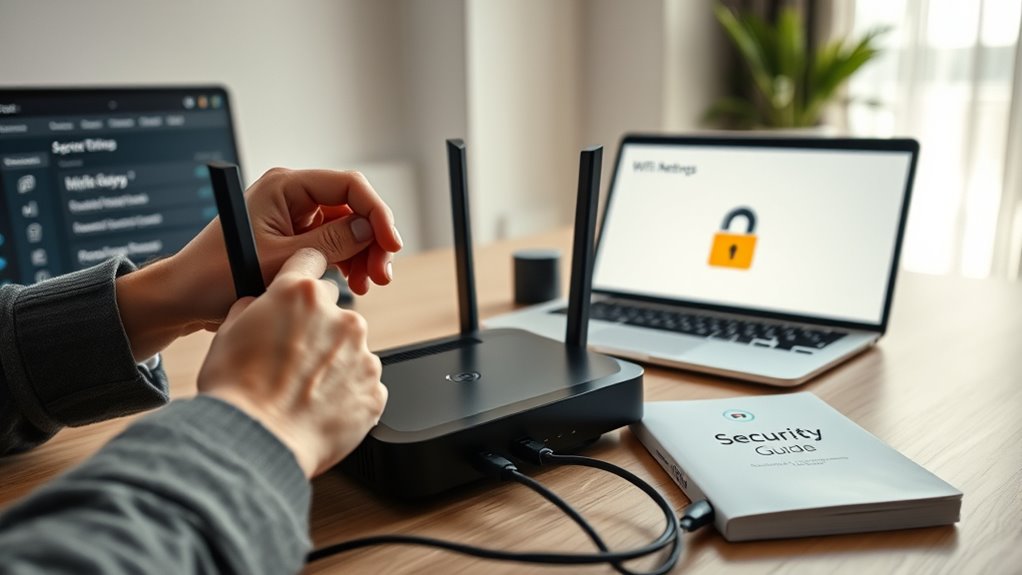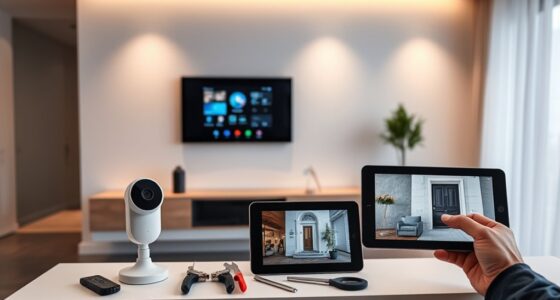To set up a secure home Wi-Fi network, place your router centrally and update its firmware regularly. Change default passwords to strong, unique ones, and enable the latest WPA3 encryption. Activate your router’s firewall, use a guest network for visitors, and disconnect unfamiliar devices. Enable multi-factor authentication when possible, keep all connected devices updated, and consider using a VPN on unsecured networks. Following these steps enhances your security and shields your devices from threats. Keep exploring to learn more advanced tips.
Key Takeaways
- Place your router centrally and update its firmware regularly for optimal coverage and security.
- Change default login credentials and enable the latest encryption standard like WPA3.
- Activate the router’s firewall, and regularly monitor connected devices for suspicious activity.
- Use strong, unique passwords for your network and set up a separate guest network for visitors.
- Keep all connected devices updated, enable multi-factor authentication, and consider using a VPN for added security.

Setting up a secure home Wi-Fi network is vital to protect your personal information and keep unwanted intruders out. Your first step is to place the router in a central location within your home. This guarantees maximum signal strength throughout your space and minimizes the chances of signals leaking outside, which could be exploited by hackers. Once the router is in place, update its firmware and software regularly. Manufacturers often release patches that fix security vulnerabilities, so staying current is essential.
Next, change the default login credentials for your router. Default usernames and passwords are widely known and can be exploited easily. Create strong, unique passwords that include a mix of uppercase and lowercase letters, numbers, and special characters. This simple step markedly reduces the risk of unauthorized access. Additionally, enable the latest encryption standard, such as WPA3, to secure your wireless communications. WPA3 offers much better security than older protocols like WPA2, making it harder for intruders to intercept your data.
Activating your router’s firewall is another vital step. Firewalls act as gatekeepers, blocking unauthorized access attempts and filtering out malicious traffic. Coupled with this, disabling remote access to your router prevents outsiders from making changes to your network settings without your permission. Regularly verify which devices are connected to your network to identify any unfamiliar or suspicious devices. If you spot anything unusual, disconnect those devices immediately.
You should also leverage a guest network for visitors. Creating a separate network isolates their devices from your main network, reducing the risk of malware spreading or unauthorized access to your personal data. Use a strong, unique password for this guest network, and consider setting time limits to restrict access duration. Monitoring activity on this network helps you detect any malicious behavior early.
For added security, enable multi-factor authentication (MFA) on your network devices and accounts whenever possible. MFA adds an extra layer of protection by requiring a second verification step, making it much harder for hackers to gain access even if they acquire your passwords. Keep all connected devices updated with the latest security patches, including antivirus software, to protect against malware and vulnerabilities.
Finally, consider using a Virtual Private Network (VPN) when connecting to public Wi-Fi or other unsecured networks. A VPN encrypts your internet traffic, shielding your data from prying eyes. Regularly reviewing your network’s security settings and educating everyone in your household about cybersecurity best practices also helps maintain a robust defense. By following these steps, you’ll create a safer, more secure Wi-Fi environment that safeguards your digital life from threats.
A good understanding of network security principles can further help you fine-tune your settings and defend against emerging threats.
Frequently Asked Questions
How Often Should I Update My Wi-Fi Password?
You’re wondering how often to update your Wi-Fi password. Experts recommend changing it every three months to keep your network secure, especially if you have many connected devices or live in a high-risk area. However, if you rarely share your password or have a complex, strong one, you might stretch that to once a year. Keep an eye out for suspicious activity or unauthorized devices, and change it immediately if needed.
Can I Hide My Wi-Fi Network From Nearby Devices?
Yes, you can hide your Wi-Fi network from nearby devices by disabling the SSID broadcast in your router settings. This makes your network invisible to casual users scanning for Wi-Fi. However, keep in mind that this doesn’t provide real security; advanced tools can still detect hidden networks. For better protection, focus on strong encryption like WPA3, use complex passwords, and keep your firmware updated.
What Is the Best Way to Secure Iot Devices on My Network?
You want to keep your IoT devices safe, and the best way is to isolate them from your main network. Use VLANs or a guest network to prevent unauthorized access. Set strong, unique passwords, enable two-factor authentication, and keep firmware updated. Regularly monitor network traffic for suspicious activity. Encrypt data with HTTPS or TLS, and choose devices with local APIs for better control. These steps work together to protect your smart home.
Should I Enable Guest Networks for Visitors?
You should enable guest networks for visitors to keep your main network secure. Guest networks isolate visitor traffic, reducing the risk of unauthorized access to your personal data and devices. They also contain malware if a guest’s device gets infected. By setting up a separate, password-protected network, you maintain privacy and control, making it easier to manage security while allowing guests internet access without compromising your main network’s safety.
How Do I Detect Unauthorized Devices Connected to My Wi-Fi?
Think of your Wi-Fi network as a busy highway. To spot unauthorized devices, first log into your router’s admin panel using your credentials. Check the list of connected devices, cross-reference MAC addresses, and identify unfamiliar ones. Use network monitoring apps like Fing to scan for rogue users. Regularly update your Wi-Fi password, disable WPS, and enable notifications for new connections—keeping your network safe from uninvited guests.
Conclusion
By taking these simple steps, you’re gently steering your home Wi-Fi into a safer harbor. Think of it as giving your network a cozy, private space where only trusted guests are welcome. With a little attention and care, you’ll enjoy peace of mind knowing your digital little corner is protected. So, go ahead—secure your connection and let your online adventures unfold smoothly, confidently, and comfortably. Your digital sanctuary is just a few easy adjustments away.










